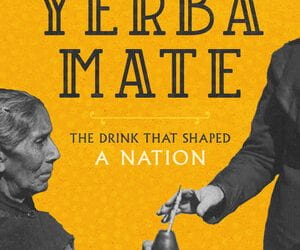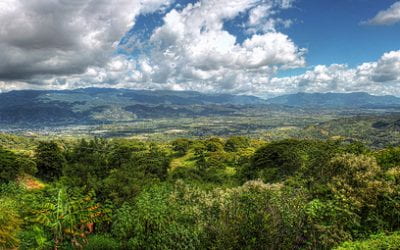Fruit and Axes of Gold
Consuming Indigenous Heritages in Nicaragua
Around the time I was born, the Oglala Lakota activist—at the time—associated with the American Indian Movement (AIM), Russell Means, visited Nicaragua and met with Indigenous peoples who had sided with the contras against the leftist Sandinista government. He promised to bring over a hundred Native American warriors to the country to help topple that government which had, less than a decade before, worked with Indigenous people to defeat a dictatorship supported by the United States. The Revolution itself was arguably ignited in the Chorotega community of Monimbó, although the Indigenous uprising began for its own purposes. Means’ promise of an army of Indigenous resistance never came to fruition, nor did he seem to consider that there were many Indigenous people who supported the Sandinistas, both in Nicaragua and within AIM.
To many, Indigenous in Nicaragua meant people on the Atlantic side of the country: the Mosquito Coast. But this ignores the very roots of the story of what would become Nicaragua. It does so willingly to erase Indigenous peoples who remain in plain sight, as part of the Latin American Myth of mestizaje, a process of “mixture” and acculturation (making the “ladino” and the “mestizo”) that can be viewed alongside the logic of elimination of settler colonialism that has been described in detail within Native American and Indigenous Studies. Simply, for the “ladino” to come into being, Indigenous people had to be consumed by dominant society—as a lower class, of course. It also meant that elements of their heritage had to be co-opted by ladino society as a shared past from which they have emerged thanks to Spanish civilizing efforts. Mestizaje wanted Indigenous pasts and heritage but did not want current Indigenous bodies— they needed to remain in the past.
When Gil González Dávila first met my people and spoke with the man he called Diriangen (a title, rather than a name) to announce the requerimiento to either convert to Christianity and submit to the Crown of Castile or die, he was offered food and a set of golden axeheads to sate the Spaniards’ well-known lust for gold. The conquistador took the axes, whereupon he was told that if he was still in the area in three days, he would receive the answer of the Dirianes of Manquesa. Seemingly not understanding a threat, his party stayed and was duly met by thousands of warriors. González was forced to retreat and seek refuge with the Nahoas to the south whom he had previously encountered. But these people who had days earlier bowed to the requerimiento had become as welcoming as Diriangen, humiliating the would-be conquerors and ejecting them from the lands that would come to be called Nicaragua. Axes of gold are not the gift one might think.
Humiliation bred inhumanity in the Spanish upon their return. The invaders met Indigenous resistance and interaction with brutality. The peoples of Manquesa (today collectively called by the Nahoa name for them: Chorotega) were enslaved, burned alive, fed to packs of dogs for daring to resist colonization. With religious practices outlawed on pain of death, Chorotega people adapted, obscuring our spirituality under masks acceptable to the Spanish. The black-skinned woman of the volcano became St Jerome (with a title that might call back to her appearance), sacred deer became donkeys and horses, and trickster figures became old Indigenous men. The Chorotega adapted to survive and in doing so created enduring works. One such, the masked performance of El Güegüense, was not only an act of Indigenous concealment of ritual but an act of survival and anti-colonial resistance, with the trickster Güegüense mocking and deceiving the Spanish. So subversive was this work that it was outlawed for a time. And still it endured, like the spirit of Indigenous people.
Today, El Güegüense, is considered a hallmark of Nicaraguan culture, and was awarded the mantle of Intangible World Heritage by UNESCO as a work emblematic of the Nicaraguan spirit of resistance. As with the uprising in Monimbó, that community’s masked performance of El Güegüense was adopted and drawn into mestizaje, despite speaking to a very different -and Indigenous- reality. It has become a symbol etched into the state tourism brand of Nicaragua, marketed abroad to draw tourists to visit and ignore stories of the country’s civil strife.
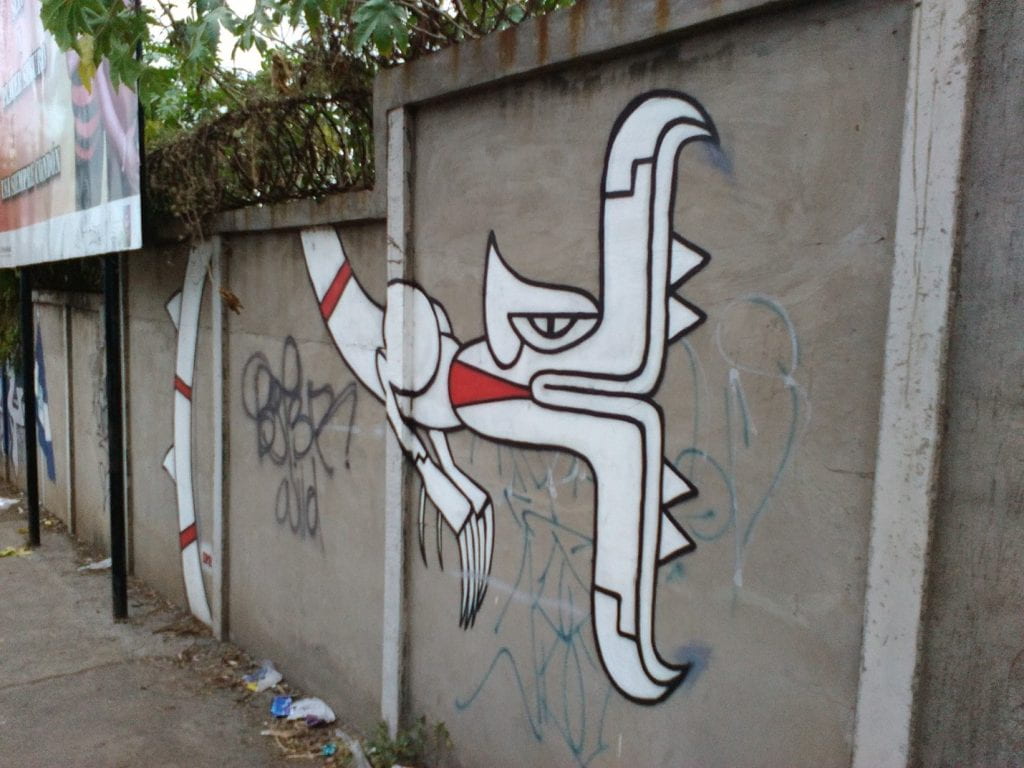
Artwork in Masaya depicting a plumed serpent Photo by Paul Edward Montgomery Ramírez.
Wearing Indigenous Masks
On the island of Ometepe in the middle of Lake Nicaragua, I watched alongside some rather bemused townsfolk as the man in dreadlocks and his partner danced around statues that had survived invasions, piracy, war and colonization. They whirled and whooped in their Concheros regalia around four pennants, each from a different color of the “four elements” found in New Age Mayanism: red fire, black earth, white air and blue water. This makeshift cloth altar was adorned with a conch, feathers, obsidian and a rattle.
Their dance completed, they spoke to the onlookers about how everyone must return to their Indigenous knowledges and lifeways to bring peace. A hat was left out for donations. The man’s regalia had a large Ometeotl symbol across his chest, the symbol used within Mayanism and the Mexica Movement. His loincloth had a depiction of the plumed serpent that could be found at Lago de Asasosca in Managua, its story connected to the Chorotega. He introduced himself to me as an Indigenous man from a pueblo indígena in Matagalpa, in the Nicaraguan central highlands. The name he gave me was Kan Ek’. It was an odd name to me, one that belonged to the rulers of the last independent Maya kingdom—and one adopted by the Maya revolutionary, Jacinto Canek, in his mid-18th century rebellion against Spain.
Someone performing dances from Indigenous peoples of central Mexico, using New Age symbolism and art connected to Chorotega histories, while claiming to be from a community of Matagalpinos and using a distinctly Maya name certainly sent mixed signals. In later years, I would find out that he had started claiming to be a sukya (wiseman) of the Miskitu people from the Atlantic coast of Nicaragua. Beyond his “Mexica” dances, Kan Ek’ had started conducting ayahuasca, rapé and temazcal (sweat lodge) ceremonies for tourists, as well as other New Age services like reiki. Tourists could work on his land for a time, while paying him for access to traditional shamanic knowledge. His services had also moved abroad to retreats and events with varying costs, upwards to several hundred US dollars per participant. While selling “Indigenous knowledge,” Kan Ek’ also has been able to solicit donations to purchase more land so his “pueblo” could defend it against colonial encroachment. It seems that the colonists had already arrived.
As I spoke with Kan Ek’, one of the children with his troop began to climb on the statues that had been only moments before been offered dance, drums, whooping and prayer. They were admonished by the French dancing partner who reminded them that these were their ancestors and should be given more respect. While those statues could well depict ancestors of those children, and are worthy of respect by all, it cannot be said that the dancing troupe showed much greater reverence. Despite decrying colonialism, they replicated it while wearing Indigenous masks. The story advanced by Kan Ek’ showed that his Indigenous connections were scarce and how willing others were to believe in his alleged “authenticity.”
In areas where Indigenous heritage is obscured and underrepresented, New Age fraud draws on better known elements of indigeneity in Latin America which is seen as legitimate by outsiders who wish to engage with “the Indigenous”. This twisted image of Indigenous peoples in Nicaragua is given prominence, presence and payment—but does not reflect the Indigenous peoples living there or in the diaspora. Appropriations of the Indigenous take many forms. These dancers are only one face of the continued consumption of Indigenous heritages to benefit those outside of their communities. It is the very essence of colonization.
Consuming the Indigenous
Whether those statues the pair danced around, and their children climbed on would survive the heritage industry was up for debate. One of the necks of the figures was a lighter color, resulting from restoration work after accidentally being decapitated—I was told—as they were transferred to a shelter built to protect them from destructive rains. These were hardly the only works of rock art to be relocated in the name of tourism; many that were not stolen away into distant museums dotted the trails or central grounds of fincas that had been transformed into hotels.
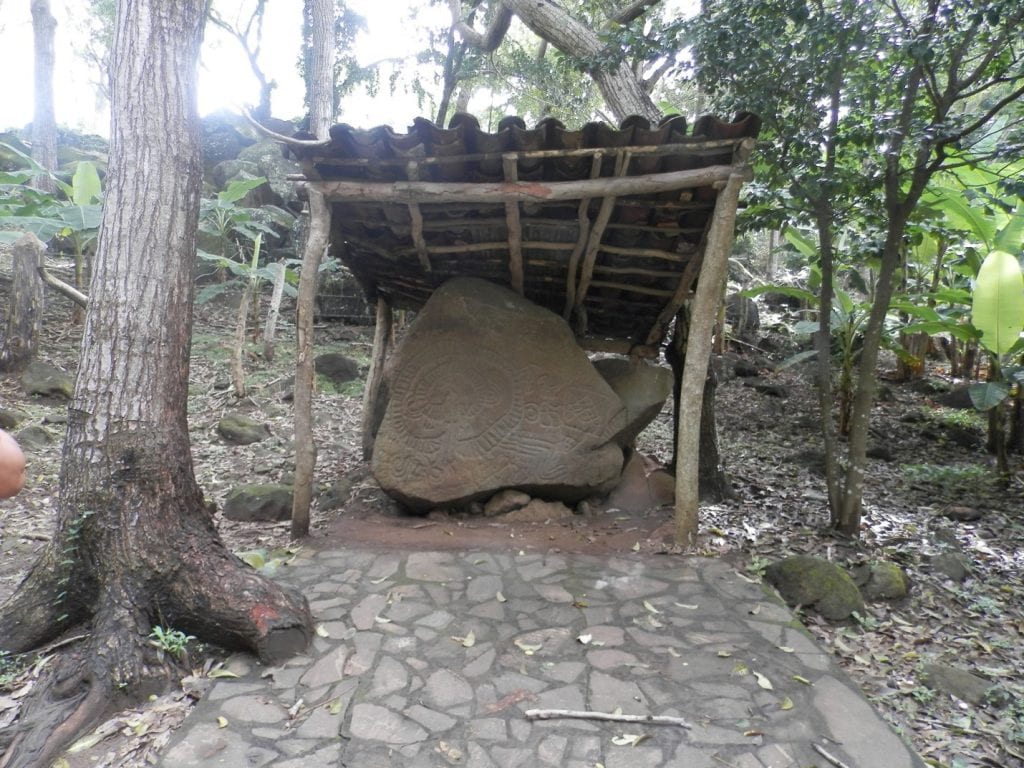
A petroglyph relocated and repositioned on a finca’s pathway Photo by Paul Edward Montgomery Ramírez .
Displaced from their contexts, these works of Indigenous heritage become items of easy consumption. Away from the landscapes in which they were made to interact with, a sacred cultural work becomes a mysterious work of art of a mysterious past. Oral histories involving statues and petroglyphs becomes easier to ignore and perhaps erase if they are removed from their sacred landscapes. This should not be seen as a willful and malicious erasure, but one that has placed the concerns of touristic consumption and Western conservation above the intangible heritages that flow through the land and tangible works.
Ometepe is far easier to visit than when I was a child, now with an airstrip so tourists would not have to brave the lanchas that took freight and people to the island. Planes also allow visitors to ignore that climate change and tourist water consumption impacted the lake so greatly that at times these boats could simply not dock. And in this pursuit of tourism money, which has come to be a massive industry in Nicaragua, ease of access to the consumer comes at a price. The realities of tourism’s strain on infrastructure and resources are hidden. Heritage is packaged into items easily consumed. It is wrapped into something easily accessible, something “authentic,” something uncontested, unproblematic. And in doing this, heritage is seized by the moneyed and powerful.
Visiting several petroglyphic sites on the island, landowners asked repeatedly what I thought the stones were saying, or if I knew any stories about them. They did not want an Indigenous story from me, but rather the authoritative explanation of an archaeologist— something that could be reliably retold to other tourists. At one stone I asked if this was the place the stone was found. The landowner said that it was found several miles away, but that it was easier for people to visit where he had placed it. I must have had an expression on my face because he asked me why that mattered. My explanation was unsatisfactory to him. Later, I was led through the woods to another site.
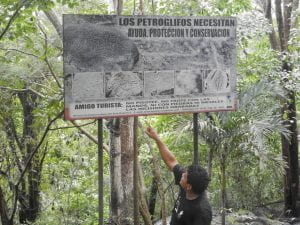
Sign telling of the importance of conserving petroglyphs left in situ Photo by Paul Edward Montgomery Ramírez.
There, dozens of stones remained as they had been before the arrival of the Nahoas to the island. A metal sign was posted near them reminding would-be-visitors of the importance of their preservation. Not a hundred yards away, we encountered a team removing trees that were several feet wide as they built a paved trail to the site.
Beyond real concerns of the destruction of tangible heritage or the mystification of its significance through use as a touristic resource, the risk to the intangible cannot be ignored. As Indigenous people are consigned to a passive past, our works and their meanings are spun into the dominating mat of mestizaje. Ties to landscape are swept up in tourism and stories reframed within a lens that glorifies the ladino, the mestizo while tourism revenues barely trickle into Indigenous hands. These appropriations and consumptions into Nicaraguan-ness are so powerful, that in order to act out Indigeneity, many are forced to act out stereotype that has very little to do with their living culture. New Age frauds are deemed “authentic” while Indigenous practices are called lo tipico, and the people called campesinos. Images of Indigenous resistances—like El Güegüense—become Nicaraguan, and Indigenous peoples are placed in the margins, made to watch tourists pay the powerful to consume their spirits.
Paul Edward Montgomery Ramírez is a Nicaraguan-American public archaeologist affiliated with Cleveland State University.
Related Articles
A Review of Yerba Mate: The Drink that Shaped a Nation
On any given day, millions of South Americans—in the subcontinent and around the world—would engage in the same ritual. We heat water (making sure it doesn’t boil), prepare the mate, and sip, sip and sip. But where does that green, earthy, addictive, and for many outside South America exotic, drink comes from?
Editor’s Letter – Indigenous Voices
Editor's LetterFrom the Maya in Guatemala to the Mapuche in Chile, Latin America’s Indigenous peoples are on the forefront of fighting for rights, whether against mining and deforestation or for land rights or the right to express themselves as a culture. We divided...
The Health of Indigenous Populations in Mexico: Disencounters
English + Español
In the year 2000, we participated with Médecins Sans Frontières (MSF) in a medical-humanitarian project in impoverished indigenous communities in San Juan Cancuc, in the region of Los Altos de Chiapas.

